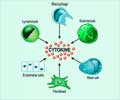A study conducted at the University of Pennsylvania School of Medicine appears to have uncovered a reason as to why the Ebola virus is such a powerful, deadly, and effective virus.
The researcher behind the study have revealed that they used a cell culture model for Ebola virus infection, and found that the virus disables a cellular protein called tetherin that normally can block the spread of virus from cell to cell."Tetherin represents a new class of cellular factors that possess a very different means of inhibiting viral replication," says study author Paul Bates, PhD, Associate Professor of Microbiology at the University of Pennsylvania School of Medicine.
"Tetherin is the first example of a protein that affects the virus replication cycle after the virus is fully made and prevents the virus from being able to go off and infect the next cell," he adds.
When a cell is infected with a virus like Ebola, which is deadly to 90 percent of people infected, the cell is pirated by the virus and turned into a production factory that makes massive quantities on new virions, according to background information in a research article in the online edition of the Proceedings of the National Academy of Sciences.
These virions are then released from that cell to infect other cells and promote the spreading infection.
Known as one of the immune system's responses to a viral infection, tetherin stops the infected cell from releasing the newly made virus, thus shutting down spread to other cells.
Advertisement
"This information gives us a new way to study how tetherin works. Binding of a protein produced by Ebola to tetherin apparently inactivates this cellular factor. Understanding how the Ebola protein blocks the activity of tetherin may facilitate the design of therapeutics to inhibit this interaction, allowing the cell's natural defense systems to slow down viral replication and give the animal or person a chance to mount an effective antiviral response and recover," says Bates.
Advertisement
The new findings suggest that human cells also use this defence against other types of viruses, such as Ebola, that are not closely related to HIV-1.
"Because we see such broad classes of viruses that are affected by tetherin, it's possible that all enveloped viruses are targets of this antiviral system. If so, then understanding how tetherin works and how viruses escape from the effect of tetherin will be very important," says Bates.
Source-ANI
PRI/SK












